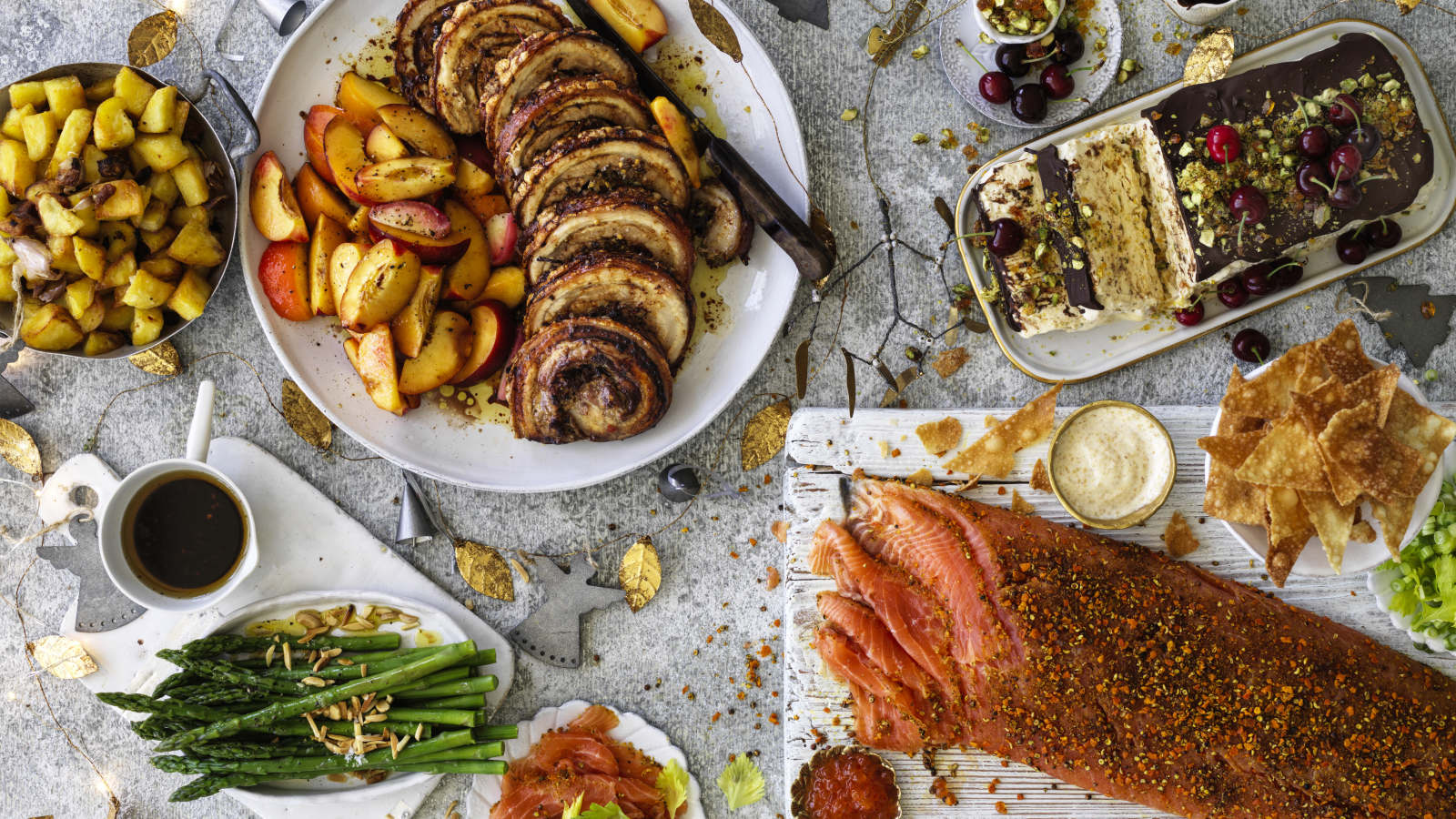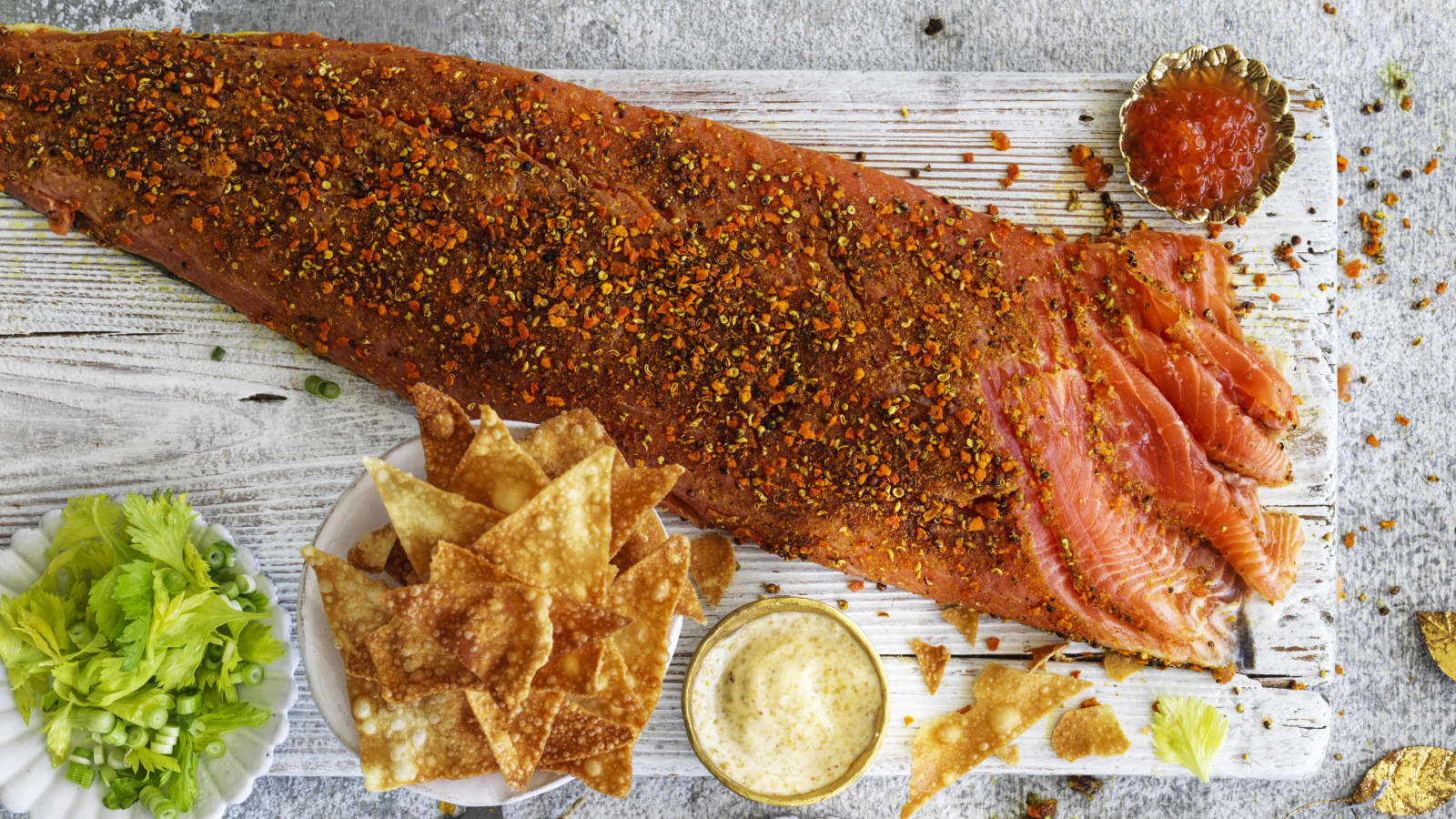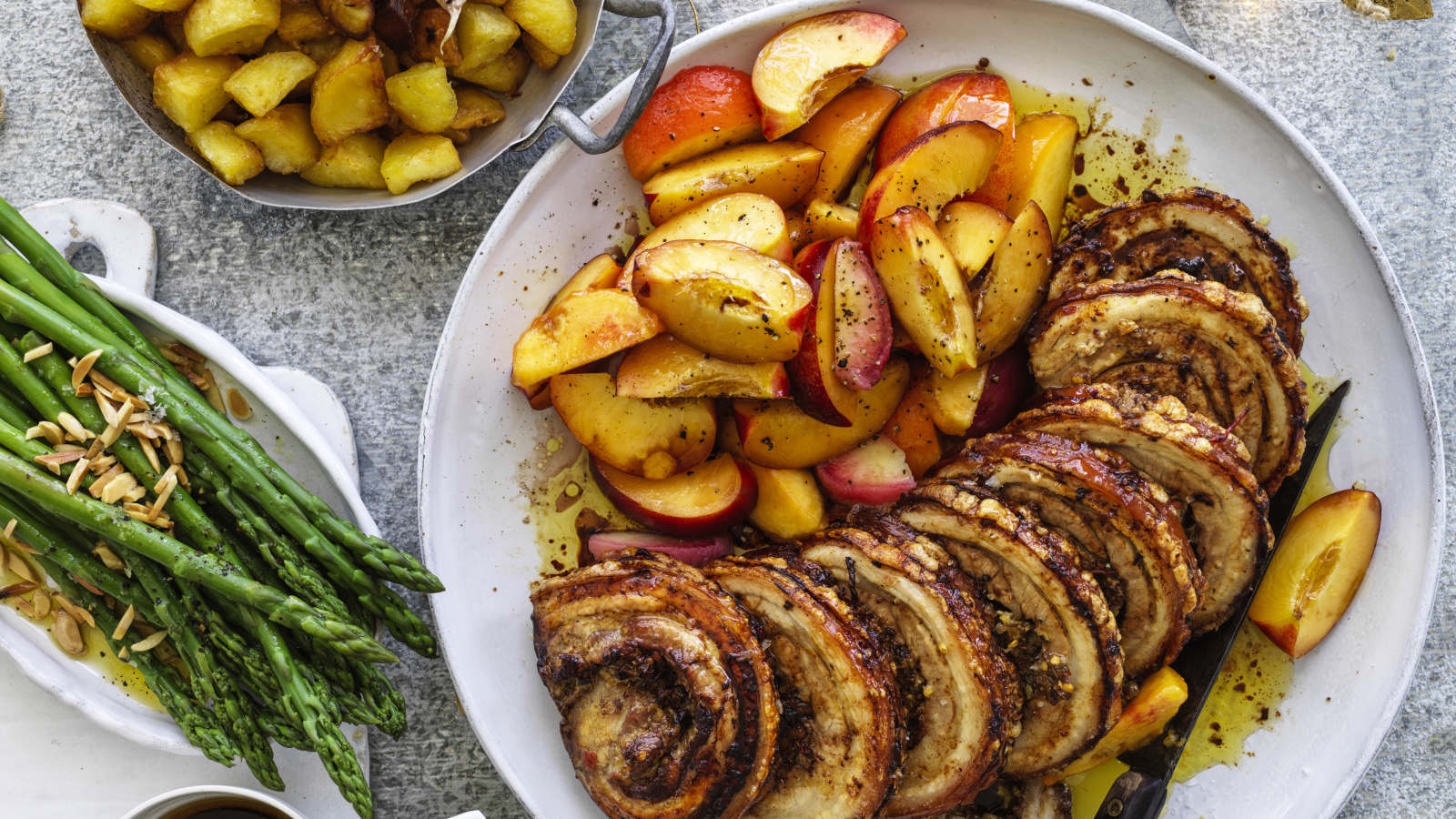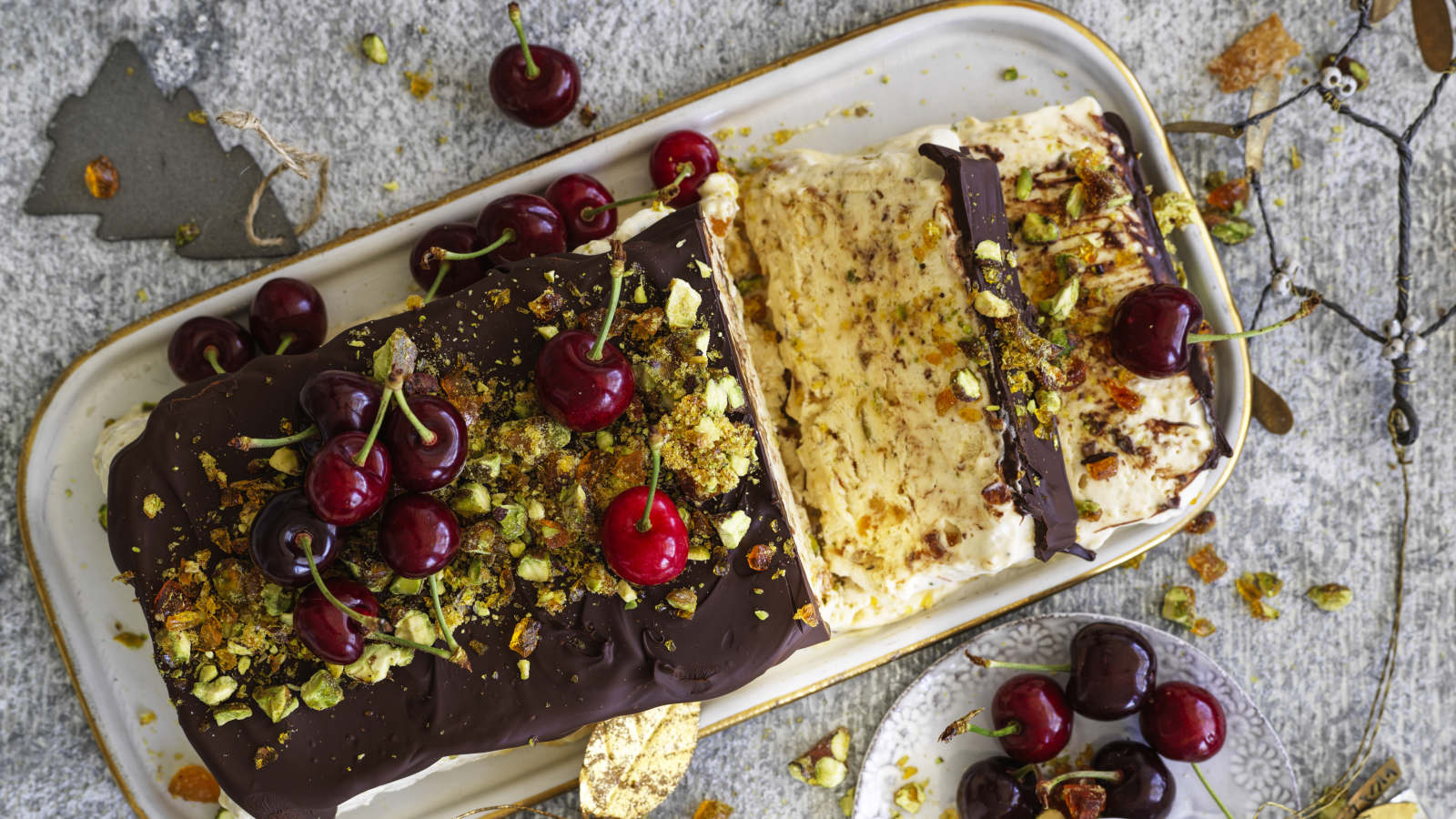The ultimate festive feast to serve up this Christmas
by Neil Perry, Karen Martini and Helen GohSpice up the traditional Christmas meal with a three-course feast that riffs on Asian and Italian flavours.

Citrus-cured ocean trout with sesame mayonnaise
By Karen Martini
I can’t remember a Christmas where I haven’t cured a side of ocean trout or salmon, using it in various ways over the main days of entertaining. Sometimes it’s down a traditional line, served with crème fraîche, shallots, caperberries and chopped egg on rye toast or lavash. But I also love it pushed in different directions. This Asian version is brilliant for setting the mood for a great lunch to come.
The base recipe for the cure is something you can adapt to your needs. Omit the Sichuan peppercorns and coriander seeds for a more classic result. Once the fish is cured, just brush it with dijon mustard and coat with chopped dill before wrapping and refrigerating.

SERVES 15–20 AS A STARTER
1.2–1.5kg side of ocean trout (or salmon), skin on, trimmed and pin-boned
peel from 2 mandarins (or oranges)
1½ tbsp Sichuan peppercorns, lightly toasted
2 tsp white peppercorns, finely crushed
1 tbsp extra virgin olive oil
½ tsp sesame oil
24 square wonton wrappers, cut in half into triangles
oil for shallow-frying
FOR THE CURE
200g rock salt
120g caster sugar
10g (about 2 tbsp) coriander seeds, lightly ground
10g (about 2 tbsp) Sichuan peppercorns, lightly ground
5g (about 1 heaped tsp) white peppercorns, lightly ground
juice and zest of 2 lemons
juice and zest of 2 limes
FOR THE MAYONNAISE
250g thick mayonnaise (like Kewpie)
50g sesame seeds, toasted and ground
2 tsp sesame oil
2 tbsp rice wine vinegar
TO SERVE
small yellow celery leaves
finely sliced shallot (spring onion)
trout or salmon roe
lime wedges
1. Combine the cure ingredients in a bowl until it’s an even slurry.
2. Lay two long overlapping lengths of cling wrap on a tray or dish that will fit the trout lying flat. Press them together along the seam, then pour in half the cure, spreading it out along the length of the tray. Lay the trout on the cure, skin-side down, then pour the remaining cure over the top. Seal the parcel tightly with the overlapping cling wrap, ensuring the trout is evenly covered. Refrigerate for 24 hours, opening the parcel and turning the trout after 12 hours, then resealing.
3. Dehydrate the mandarin peel on a tray in the oven at 100°C (80°C fan-forced) for about 3 hours until brittle but still brightly coloured, not brown. Blitz in a spice grinder until fine, add the Sichuan pepper and white pepper and blitz again.
4. Once cured, remove the trout from the slurry (it will have firmed up and shed lots of water) and wipe clean with a damp cloth. Combine the olive and sesame oils and brush over the trout, then press on the mandarin dust. Wrap tightly in cling wrap and refrigerate for at least an hour before slicing (the trout will keep for about 10 days like this).
5. Combine the sesame mayonnaise ingredients well and refrigerate until needed. (Transferring it to a piping bag makes serving easier and more elegant, but it’s not essential.)
6. Fry the wonton wrappers in about 4cm of oil at 180°C for 2 minutes on each side, then drain on kitchen paper.
7. Slice the trout on an angle, then lay half a slice on a wonton triangle. Top with a dollop of mayonnaise, a celery leaf, some shallot and a couple of pearls of roe. Serve immediately with lime wedges. (If you let this sit for long, the wonton wrappers will soften.)
Porchetta with peaches and nectarines
By Neil Perry
This is the best of Christmas and summer in the one dish. By all means, add any fruit you love to the salad – any stone fruit would be incredible. I like to barbecue the fruit to give it a charred flavour and then add the dressing. You will get the most out of it by adding the best balsamic vinegar you can afford.
Serve with sides of garlic roasted potato and blanched asparagus topped with olive oil, freshly ground black pepper and slivered almond.

SERVES 8
1.2kg boneless pork belly, skin on
20 garlic cloves, peeled
1 tbsp fennel seeds, roasted and ground
1 tbsp coriander seeds, roasted and ground
½ tsp mild chilli flakes
6 sage leaves, coarsely chopped
sea salt and freshly ground black pepper
1 tbsp olive oil
2 lemons, cut into quarters
FOR THE SALAD
3 slipstone peaches, blanched and peeled
3 nectarines, skin on
2 tbsp extra virgin olive oil
1 tbsp aged balsamic vinegar
1. Lay the pork on a board, skin side up. Score the skin at ½ cm intervals using a very sharp knife or box cutter, cutting down to where the skin meets the fat (no deeper).
2. Place the pork on a tray, skin side up, and place in the fridge overnight, uncovered, to dry out. This is important for the crackling.
3. Place the garlic in a saucepan of cold salted water and bring to the boil, then simmer gently for about 20 minutes or until the garlic is cooked and tender. Remove the garlic.
4. In a small bowl, mash the garlic with a fork, add the fennel, coriander, chilli, sage and a pinch of sea salt and mix well. Remove the pork from the fridge and rub the garlic paste into the flesh side.
5. Preheat the oven to 240°C (220°C fan-forced). Lay the pork belly skin side down on a large chopping board and roll into a log, tying with kitchen string at 3cm intervals. Rub with lots of sea salt and olive oil, set aside and allow pork to come to room temperature.
6. Place the pork on a wire rack over a roasting pan and roast for 20 minutes. Reduce heat to 160°C (140°C fan-forced) and roast the pork for a further hour until it measures an internal temperature of about 56°C. Remove and rest for about 30 minutes – the internal temperature will rise by 4°C or 5°C as it cooks the pork through.
7. To make the salad, cut the peaches and nectarines in half and then cut each half in thirds. Place in a bowl and season with sea salt and pepper, add oil and vinegar, and toss together.
8. Place pork on a chopping board, remove the string and cut into 8 slices. To serve, drizzle with extra virgin olive oil and top with a sprinkle of sea salt and a grind of fresh pepper. Spoon some of the fruit and dressing next to it.
Pistachio semifreddo with chocolate and cherries
By Helen Goh
Here is a fabulous frozen dessert that doesn’t require an ice-cream machine and can be made up to a week ahead of serving on Christmas Day. It can be made in individual moulds or ramekins, but I love the idea of bringing a centrepiece to slice at the table.
Although there are several components to this recipe, it’s relatively straightforward when you break it up into stages. For example, you can make the praline a few days ahead and store it in an airtight container in the freezer until ready to make the semifreddo.

SERVES 8
FOR THE PRALINE
2 tbsp water
125g caster sugar
90g pistachio nuts
FOR THE SEMIFREDDO
480ml double cream
1 tsp vanilla extract
3 egg yolks
1 egg
50g honey
50g caster sugar
¼ tsp salt
50g candied mixed peel or citron, finely chopped
TO SERVE
120g dark chocolate, melted
fresh cherries
1. Line a large loaf tin (approx 23cm x 13cm x 7cm; 1.4 litre capacity) with baking paper, leaving an overhang on the sides.
2. Start by preparing the praline. Line an oven tray with baking paper and set aside. Combine the water and sugar in a small saucepan and stir over low heat until sugar has melted. Increase the heat to medium and simmer, without stirring the syrup, until it begins to turn brown at the edges. Gently swirl the pan so that the caramel cooks evenly – again, do not stir. When it has turned a deep amber colour, add the pistachio nuts, stirring just once, then tip the caramel onto the lined baking tray.
3. Set caramel aside to cool completely, then break into pieces and place in the food processor. Pulse until roughly chopped – irregular is good, but you don’t want pieces larger than about ½ cm. Transfer to an airtight container and set aside until ready. (If not using the same day, store in the freezer for up to 1 week.)
4. For the semifreddo, place the cream and vanilla in the bowl of a cake mixer fitted with the whisk attachment and beat until soft waves form. Transfer to a bowl and keep refrigerated.
5. Fill a medium saucepan a quarter full of water, place over medium heat and bring to a simmer. Whisk the egg yolks, whole egg, honey, sugar and salt in the bowl of the cake mixer and set it over the simmering water. (Make sure the bottom of the bowl does not touch the water.) Whisk continuously until the sugar has dissolved and the mixture is very warm (about 5 minutes).
6. Immediately transfer the bowl to the cake mixer with the whisk attachment in place and beat on medium-high speed until the eggs have doubled in volume and the bowl is no longer warm to the touch (about 5 minutes).
7. Transfer the mixture to a large bowl, then add about a third of the chilled whipped cream. Fold through until it looks streaky, then add another third of the cream. Fold again, then add the mixed peel, most of the praline mix (reserve 2 tbsp for the garnish), and the rest of the cream. Fold until incorporated and no white streaks remain. Scrape the mix into the prepared tin and smooth over the top with a small spatula. Cover with cling wrap and freeze for at least 12 hours.
8. When ready to serve, remove from freezer and invert onto a serving platter. Spoon melted chocolate on top, letting it drip naturally and attractively down the sides. Place some cherries on top of the chocolate and sprinkle the reserved praline all over. Garnish with more cherries around the platter and bring to the table. Slice with a hot knife (dipped in a tall jug of hot water, then wiped dry) into 3cm-thick slices and serve, with fresh cherries on the side.
To read more from Good Weekend magazine, visit our page at The Sydney Morning Herald, The Age and Brisbane Times.